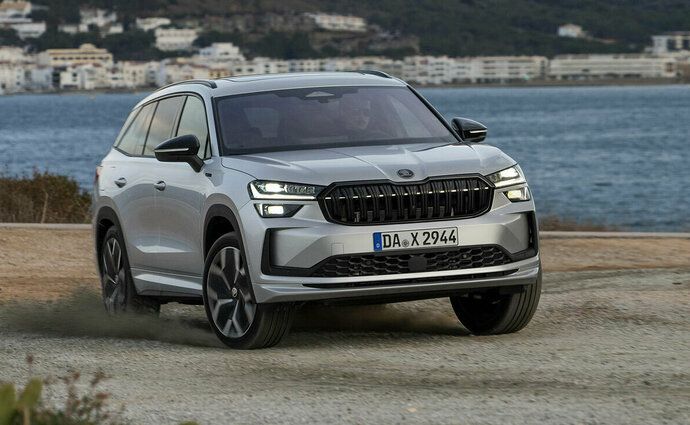The second generation Škoda Kodiaq was introduced at the beginning of last October. However, we had to wait until now for the first live impressions with unmasked prototypes. Less than a month after the first kilometers behind the wheel of the technically related Superb, a more important novelty also arrived at the store. While around 67,400 Superbs were sold worldwide last year, the Kodiaq SUV was the third most popular Škoda with 105,900 copies. Only the small crossover Kamiq (116,500) and the sovereign Octavia with almost 192,000 cars were better off.
Although the novelty is already decorated with elements of the Modern Solid stylistic language, at first glance it looks more like a facelift of the outgoing generation. The proportions remained very similar, the Škoda Kodiaq is therefore more reminiscent of a raised station wagon (similar to the Audi Q7). Compared to the older model, the second edition is 59 millimeters longer (4758 mm). The wheelbase was extended by just three millimeters to 2791 mm, but there was already enough space in the original Kodiaq.
In the seven-seat configuration, you can now look forward to a more voluminous luggage compartment. Instead of 270 litres, you have seventy more at your disposal. In a five-seater arrangement, the car can carry 910 liters (+75 l), after folding the rear backrests, even over 2.1 cubic meters.
In the interior, we can find four USB-C ports for charging mobile phones, which will give a power of up to 45 W, as well as two compartments for 15 W wireless charging of smartphones with cooling, so that devices do not overheat. For the first time, the Kodiaq also gets a clear head-up display, which is available as an option.
As in the Škoda Superb, in the cabin you will come across a trio of partially configurable Smart Dials. The wheels with a diameter of 32 mm have small displays inside, while the outermost ones are responsible for choosing the temperature and heating or cooling the front seats. With the middle one, you can switch between audio volume, ventilation intensity, air flow direction and driving.
The cabin is a little more imaginative than its predecessor, but I was mainly surprised by the quality of the workshop workmanship. At first glance, the place where savings were made is minimal. The vast majority of internal parts have a very pleasant and high-quality surface. I tried to press the individual parts with force, but not one of them made a sound. At the same time, especially the door panels and the center panel will collapse under the onslaught of force, but the new Škoda Kodiaq is obviously robust enough not to crumble even on broken Czech roads. At the same time, you will not automatically find such honesty even in the premium segment. The only exceptions are perhaps the Lexus and Porsche brands.
I must also praise the excellent multimedia with a 13″ display. Their response to instructions is quick, the operation much more intuitive than the octavia with a similar concept that emphasizes touch. Still, compared to the purely electric Škoda Enyaq, I miss physical buttons for direct access to selected functions. But there are optional quick shortcuts at the top of the center screen.
Finally a plug-in! Fortunately, the classic remains
Diesel engines are perfect for larger SUVs. This is no different in the case of the Skoda Kodiaq, which, like its predecessor, offers two 2.0 TDI engines: a weaker one with 110 kilowatts and a more powerful one with 142 kW. Both already have a seven-speed dual-clutch transmission as standard, no other alternative is available.
The biggest innovation of the second generation is the plug-in hybrid version (the only one with a six-speed DSG). But in this case, it is true that those who wait, will see. In the Kodiaq, we will find a new version of the combined drive, which combines a TSI fifteen-cylinder petrol engine with an electric motor with a system output of 150 kilowatts.
The traction electric unit takes energy from the battery with a very generous total capacity of 25.7 kWh, thanks to which the Škoda can travel around 100 kilometers on a single charge. Unlike, for example, plug-in hybrid BMWs, the Kodiaq boasts support for fast charging with a power of 50 kW, so you can top up the entire battery capacity during the purchase. Even the traction battery does not significantly limit the practicality of the car. You can still store up to 745 liters in the trunk.
For less demanding drivers, Škoda offers a mild-hybrid four-cylinder 1.5 TSI with 110 kilowatts, lovers of more powerful gasoline can wait for the 2.0 TSI with 150 kW, which will arrive a little later.
Škoda Kodiaq: Technical data 1.5 TSI 2.0 TDI 2.0 TDI 4×4 1.5 TSI PHEV Engine petrol four-cylinder diesel four-cylinder diesel four-cylinder petrol four-cylinder Displacement [cm3]
1489 1968 1968 1498 The greatest power of the internal combustion engine [kW/min]
110/5000-6000 110/3000-4200 142/3500-4200 110/5000-6000 Internal combustion engine torque [N.m/min]
250/1500-3500 360/1600-2750 400/1750-3250 250/1500-4000 Cylinders/Valves 4/4 4/4 4/4 4/4 Bore x Stroke [mm]
74.5 x 85.9 81.0 x 95.5 81.0 x 95.5 74.5 x 85.9 Compression ratio 12.0:1 16.0:1 15.5:1 11.5:1 Electric motor power (front) (kW) – – – 85 Electric motor torque (front) (Nm) – – – 330 System power (kW) – – – 150 Gearbox 7DSG 7DSG 7DSG 7DSG Max. speed [km/h]
207 205 220 210 Acceleration 0-100 km/h [s]
9.7 9.6 7.8 8.4 Comb. consumption [l/100 km]
5.9 5.3 6 – CO2 emitted [g/km]
151 155 174 – Fuel tank volume [l]
55 55 58 45 Curb weight [kg]
1661-1819 1730-1933 1798-2000 1913-2084 Luggage volume [l]
845 845 845 745 Dimensions lxwxh [mm]
4758 x 2133 x 1659
4758 x 2133 x 1659
4758 x 2133 x 1659
4758 x 2133 x 1659
Rozvor [mm]
2791
2791
2791
2791
Cena Selection [Kč]
–
1.040.000
1.170.000
–
Cena Exclusive Selection [Kč]
–
1.285.000
1.414.000
–
The new Škod Superb and Kodiaq generations, as well as the Volkswagen Passat Variant and Tiguan, received an even more comfortable DCC+ chassis (VW under the name DCC Pro) with adaptive dampers from the company KYB with two electromagnetically controlled valves, thanks to which the control unit can, for example, tighten the damper only in compression but not in extension. You can set them in up to fifteen different levels, from more than sporty to very soft.
A decent base
I was the first to test the basic drive in the form of a petrol 15-litre TSI on the rain-slicked Catalan roads, which is connected exclusively to front-wheel drive. The unit will have the role of a sufficiently nimble approach at shorter and medium distances, so don’t expect miracles from it. Under load, it reaches its limits quite quickly, which does not mean that it suffers dynamically. He just doesn’t impress with such a temperament.
However, what it shines in is refinement. At idle, it is hardly audible in the cabin, but even better is the damping of the vibrations of the four-cylinder engine. You practically don’t even feel them in the tips of your fingers on the steering wheel. In addition, the fifteen-piece is very effective. If you don’t step on its neck too much, it will reward you with a consumption of around 6.5 liters per 100 kilometers, which is really very nice considering the external dimensions of the Czech SUV and the car’s curb weight of at least 1586 kg (for a seven-seat version it can reach more than 1830 kilograms) result.
The tested specimen in Sportline equipment (which is still missing from the price list, as well as the 1.5 TSI engine itself) with 19″ wheels, 235/50 tires and the mentioned optional DCC+ adaptive chassis is extremely comfortable on smooth Spanish roads. Compared to the sister Volkswagen Tiguan 2.0 TDI/142 kW R-Line with wheels an inch larger, the Škoda Kodiaq dampens bumps with greater grace, as if there was an imaginary layer of cotton wool between them and the shoes to absorb shocks. And the most powerful diesel with 142 kilowatts, which is also found in the Kodiaq, behaved very similarly.
The steering has a slightly less sharp characteristic at least around the center position, the diesel top, which is at least 137 kg heavier, has a slightly faster booster response. And also a slightly stiffer ride. After all, the front wheels are loaded more than the smallest engine in the range.
Thanks to the mild-hybrid with the stop/start system activated, the four-cylinder 1.5 TSI jumps almost imperceptibly. Those who are not interested in chasing speed records and are satisfied with more lukewarm acceleration (even so, the TSI can reach 100 km/h in just under 10 seconds), should discard their prejudices about the drive being too small and weak and try the basic unit for themselves.
Diesel locomotive
The more powerful of the two diesels, the 2.0 TDI with 142 kilowatts, is the only one to offer a 4×4 drive. Another version with a four-wheel drive in the form of a 2.0 TSI gasoline with a power of 150 kW will arrive later this year. Therefore, at least initially, it will make up a relatively significant part of sales on the Czech market, although its price starts at 1,170,000 CZK.
The intergenerational loss of five kilowatts is caused by a larger SCR catalyst, or increased back pressure in the exhaust. However, the appearance of the diesel unit is otherwise de facto identical to its predecessor. The more powerful diesel shows its power mainly at higher revs. Around 3000/min it takes a deep breath and shoots forward.
According to official data, the Kodiaq 2.0 TDI/142 kW accelerates from 0 to 100 km/h in just 7.8 seconds (the seven-digit version is two tenths of a second slower). At the same time, the four-wheel drive is 1.8 seconds faster than the 110-kilowatt version of the two-liter TDI.
The eight-liter consumption of diesel is not very telling. It rained quite heavily in the vicinity of Girona this afternoon, and in this case I chose a hilly route with beautifully winding roads bordering the coast of the Mediterranean Sea. At a leisurely pace, TDI will talk about numbers starting with six.
I was pleased that the seven-speed dual-clutch DSG did not needlessly keep low revs in sight of idling, but when driving faster in corners in sports mode, the gearbox sometimes jerked when downshifting in automatic mode. However, during normal driving, the automatic transmission works without problems.
Even in this case, I have to praise the driving comfort. The heavier Škoda Kodiaq 2.0 TDI/142 kW behaved just as well as the basic 1.5 TSI on not very smooth roads. In the city, for example when crossing speed bumps, the overall stiffer suspension in combination with nineteen-inch rims was already slightly noticeable. But as soon as the shock absorbers start moving, you can look forward to a pleasantly smooth, but not rocking, ride.
A new family ideal?
I must say that the new generation Skoda Kodiaq pleasantly surprised me in many ways. It has a high-quality and sturdy interior and an even more comfortable chassis than the Volkswagen Tiguan, which didn’t like it so much in broken Prague on 20″ wheels.
Yes, the SUV from Mladá Boleslav is not exactly the cheapest, with the 2.0 TDI/142 kW engine in almost full equipment, you can still stay around 1.5 million, which by today’s standards is about a normal market price for a mainstream SUV with a length of almost 4.8 meters. At least within European car companies.
The Škoda Kodiaq also brings a lot of space for the crew and their luggage, which is why the fourth generation of the technically related Superb model will have a hard time sleeping. I can also imagine a scenario where the car will also attract some potential customers of the premium segment.
2024-04-09 16:23:00
#drive #Škoda #Kodiaq #family #ideal #miraculous #chassis


:strip_icc():format(jpeg)/kly-media-production/medias/4192793/original/064396500_1665828069-30_-_ilustrasi_astronot_unsplash.jpg)